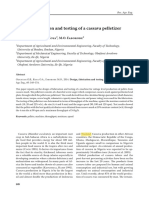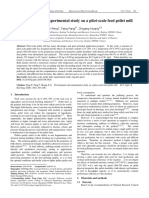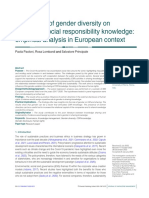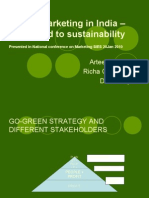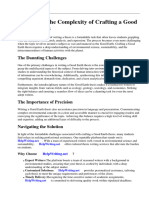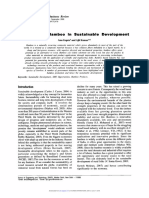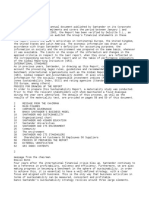Feed Pelletizer Chapter 2
Uploaded by
manueljaymar000Feed Pelletizer Chapter 2
Uploaded by
manueljaymar000Chapter 2
REVIEW OF RELATED LITERATURE
This chapter includes ideas, finished thesis, generalization or conclusion, methodologies
and others. Those that were included in this chapter helps in familiarizing information that are
relevant and like to the present study.
Design of Feed Pelletizer Machines
The design and fabrication of feed pelletizer machines have been thoroughly examined by many
researchers. The study conducted by Ogbu, Okpe, Muo, and Okoloekwe (2018) showcased the
design and fabrication procedures for a fish pelleting machine. This research study is intended to
improve productivity and profitability by aiding farmers in making their own feeds, minimizing
production costs, and implementing self-reliance. In addition, the research conducted by
Orimaye, Ajewole, and Oni (2019) worked on indigenous fish feed pelletizing machines
specified for low-income farmers in Nigeria, focusing on easy access along with affordability.
According to the study of Pathak and Vishwakarma (2021), they took part in the design and
fabrication of a cassava pelleting machine that extends the study of various types of feed
production to accommodate alternative sources. Moreover, the work of Wang, Zhang, and Huang
(2015) explored poultry feed pellet machine design, featuring the flexibility of such machinery
across diverse livestock businesses. These research studies generally highlight the significance of
innovative design approaches in feed pelletizer machinery, accomplishing all the different needs
associated with farmers and ensuring the availability of resources.
Efficiency of Feed Pelletizer Machines
The efficiency of feed pelletizer machines has been thoroughly researched in recent studies.
According to the study of Orimaye et al. (2019), they worked on the performance evaluation of a
pellet manufacturing unit in a local feed pelleting machine, showing that pelletizing efficiency
escalated with moisture content and die diameter, achieving an ideal efficiency of 98%. The
same applies to the research conducted by Ogbu et al. (2018), emphasizing the design and
fabrication of a fish feed pelleting machine, focusing on the importance of efficiency in the
design and improving feed production operations. In addition, the research of Ijabo and Adgidzi
(2020) examined the performance of a cassava pelleting machine powered by a diesel engine,
further emphasizing the importance of machine efficiency in diverse feed production settings. In
conclusion, these studies typically focus on vital technological developments and design
innovations aimed at boosting the efficiency of feed pelletizer machines.
Quality of Feeds or Pellets Produces
Physical Quality:
The quality of feeds or pellets has a vital role in guaranteeing optimal performance in
nourishment for animals. Physical qualities such as size, color, and appearance have a great
impact on the productivity of the pellets produced. The study conducted by Orimaye et al. (2019)
illustrates that using various types of die diameters, like 2 mm, 4 mm, and 6 mm, can produce
pellets of different sizes, with larger sizes emphasizing higher efficiency. In addition, preserving
the natural color of pellets is enabled by the utilization of suitable resources in designing the
machine, as emphasized by the research study of Ogbu et al. (2018). Furthermore, attaining
uniform appearance is necessary, which can be attained with the help of efficient cutting
mechanisms and effective extrusion pressure, as suggested by the same research study. The
physical quality of pellets is further mentioned in studies such as the design, fabrication, and
performance evaluation of fish meal pelletizing machines (Olusegun et al., 2018) and the design
and evaluation of pellet mills for animal feed production (Romallosa & Cabarles, 2015).
Chemical Quality:
The suitable moisture content significantly affects the pelletizing efficiency, as shown by the
researchers. According to Orimaye et al. (2019), a product with a 25% moisture content
maximizes its efficiency. Furthermore, Sharma, Pathak, and Vishwakarma (2021) verified the
result of the study, pointing out the significant effect of moisture content on the durability and
toughness of the pellet produced. This indicates the importance of maintaining the proportion of
moisture in the methods for pelletization to achieve optimal performance. In general, the
application that is advantageous to such a study in the development and performance evaluation
of a screw-like fish meal pelletizer and a cassava pelleting machine powered by a diesel engine
also enhances the significance and capitalizes on the moisture content for better pellet quality
(Orimaye et al., 2019; Shaarma et al., 2021).
Optimal Pelletizing Machine Performance: An Examination at Dimensional Parameters
The design and fabrication of pelletizer machines prioritize the significance of various ideal
dimensions to improve their efficiency and performance. The frame dimensions provide the
structural stability and durability of the machine (Romallosa and Cabarles, 2015). Barrel
dimensions are a vital part of the appropriate compression and the physical quality in terms of
the shape of the pellets produced (Jiang, Wu, and Sun, 2019). The feed hopper dimensions must
be appropriate for the design to ensure a smooth and continuous flow of raw material into the
machine (Okolie et al., 2019b). In the study of Nenciu et al. (2022b), screw conveyor dimensions
are important for the efficiency of transferring the material through the machine. In addition,
according to the study conducted by Abubakre et al. (2014b), the die plate dimensions play a
great role in finding out the physical quality of the pellet produced in terms of its size and shape.
Last but not least, the chamber dimensions must be precisely sized to organize the different pellet
procedures (Olugboji et al., 2015b). These considerations on its dimensions generally had a great
impact on its optimal performance and efficient pelletizing machine, as mentioned in the various
studies (Romallosa and Cabarles, 2015; Jiang, Wu, and Sun, 2019; Nenciu et al., 2022b;
Abubakre et al., 2014b; Olugboji et al., 2015b).
Pelletizing Machine Performance Enhancement by Strategic Planning Power Source
Selection
The selection of power source is an important matter to consider in the design and fabrication of
pelletizing machines, as it is directly proportional to their efficiency, operating expenses, and
environmental reliability. Diverse studies enhance the significance of the selection of a suitable
power source to bring out the full potential of the machine in terms of its performance and
efficiency. Just like the study conducted by Romallosa and Cabarles (2015) and Orimaye et al.
(2019). As stated in the study of Okolie et al. (2019b) and Nenciu et al. (2022c), there is another
power source option, the diesel engine, especially in other regions where sometimes electric
supply is incompatible, while proving resilience and high torque. Furthermore, the study
conducted by Olugboji et al. (2015b) and Ikubanni, Olayinka, and Ogunsemi (2019) explores the
use of renewable resources like solar power to promote environmental sustainability and reduce
carbon footprints. The resilience of this different power source in pelletizing machines not only
highlights its functioning but also highlights wider economic goals and environmental
sustainability (Romallosa and Cabarles, 2015; Orimaye et al., 2019; Okolie et al., 2019b; Nenciu
et al., 2022c; Olugboji et al., 2015b; Ikubanni et al., 2019).
Pelletizing machine cost-effective design strategies: achieving a balance between
production costs and operational effectiveness
The cost of production of the pelletizing machine plays a vital role in affecting the design and
efficiency of the machine. Various studies have emphasized the cost implications associated with
the fabrication and preservation of the machine. The material choice greatly impacts the primary
production cost; reliable and best-quality materials will have a higher production cost but
minimize the long-term preservation costs (Romallosa and Cabarles, 2015; Ogbu et al., 2018).
Furthermore, the added complexity of the machine design, involving the different features like
the diverse die-plates and innovative control system, can sum up to the overall production cost,
while it can enhance its overall efficiency and overall production quality (Orimaye et al., 2019;
Okolie et al., 2019b). According to the study of Olugboji et al. (2015b) and Nenciu et al.
(2022b), the type of power source may also have a great effect on operational cost, with electric
motors having a lesser operational cost compared to those powered by a diesel engine in the
overall primary cost. While the study of Ikubanni et al. (2019) found that using renewable
resources, like solar-powered machines, can decrease long-term operational costs anchored to
economic goals and environmental sustainability, maximizing the available resources can lead to
a more affordable production process and economic sustainability in pellet production operations
(Romallosa and Cabarles, 2015; Ogbu et al., 2018; Orimaye et al., 2019; Okolie et al., 2019b;
Olugboji et al., 2015b; Nenciu et al., 2022b; Ikubanni et al., 2019).
Pelletizing Machine Performance Improvement Through Thorough Material Selection
The material selection in accordance with the design and fabrication of pelletizer machines will
greatly impact efficiency, performance, durability, and cost efficiency. Through the study of
Romallosa and Cabarles (2015) and Ogbu et al. (2018), high durability with the best quality can
maximize the expenses in the production process while emphasizing the impact to lessen the
machine's expenses in its maintenance and preservation. Research highlights the significance of
making use of resources that can mitigate high pressure and wear, like stainless steel and
hardened alloys, to maintain the reliability of vital parts like die plates and screw conveyors
(Orimaye et al., 2019; Okolie et al., 2019b). Furthermore, innovative choices in materials, such
as composites and coated metals, have been used to mitigate the corrosion and minimize the
overall weight, helping with the efficient use of energy and operational reliability (Olugboji et
al., 2015b; Abubakre et al., 2014b). In general, the study of Romallosa and Cabarles (2015),
Ogbu et al. (2018), Orimaye et al. (2019), Okolie et al. (2019b), Olugboji et al. (2015b), and
Abubakre et al. (2014b) states that the acceptance of advanced resources not only significantly
improves the performance of the machine but also helps with environmentally friendly methods
for production by reducing energy and waste.
You might also like
- Principles and Practice of Marketing 10th Edition Fiona Ellis-Chadwick 2024 Scribd DownloadNo ratings yetPrinciples and Practice of Marketing 10th Edition Fiona Ellis-Chadwick 2024 Scribd Download51 pages
- Introduction to Green Buildings & Built EnvironmentFrom EverandIntroduction to Green Buildings & Built EnvironmentNo ratings yet
- Design and Development of Screw-Type Pellet Machine For Aquatic Feeds With Dual Operations (#1253664) - 2962967No ratings yetDesign and Development of Screw-Type Pellet Machine For Aquatic Feeds With Dual Operations (#1253664) - 296296710 pages
- Design Analysis of Dually Operated Fish Feed PelleNo ratings yetDesign Analysis of Dually Operated Fish Feed Pelle6 pages
- A Design and Fabrication of Fish Feed Pelleting MachineNo ratings yetA Design and Fabrication of Fish Feed Pelleting Machine7 pages
- Design, Construction and Testing of A Poultry Feed Pellet Machine100% (3)Design, Construction and Testing of A Poultry Feed Pellet Machine6 pages
- The Working Principle of A Burr Pelletizer: APRIL 2021No ratings yetThe Working Principle of A Burr Pelletizer: APRIL 202157 pages
- Performance Evaluation of A Fish Feed Pelletizing MachineNo ratings yetPerformance Evaluation of A Fish Feed Pelletizing Machine10 pages
- Design and Evaluation of A Pellet Mill FNo ratings yetDesign and Evaluation of A Pellet Mill F13 pages
- Heliyon: Paul Chukwulozie Okolie, Iheoma Chigoziri Chukwujike, Jeremiah Lekwuwa Chukwuneke, Jude Ezechi DaraNo ratings yetHeliyon: Paul Chukwulozie Okolie, Iheoma Chigoziri Chukwujike, Jeremiah Lekwuwa Chukwuneke, Jude Ezechi Dara7 pages
- Design and Development of Livestock Feed Pelleting Machine: Journal of Engineering Research January 2009No ratings yetDesign and Development of Livestock Feed Pelleting Machine: Journal of Engineering Research January 200910 pages
- Best of Bast Roll Type Technical - Evaluation - of - A - Roll - Type - ExtrNo ratings yetBest of Bast Roll Type Technical - Evaluation - of - A - Roll - Type - Extr7 pages
- Fish Pelleting, Diameter Changes, RatioNo ratings yetFish Pelleting, Diameter Changes, Ratio16 pages
- DESIGN_AND_CONSTRUCTION_OF_A_FISH_FEED_ENo ratings yetDESIGN_AND_CONSTRUCTION_OF_A_FISH_FEED_E9 pages
- Development and Performance Test of Poultry Feed Mixing and PelletingNo ratings yetDevelopment and Performance Test of Poultry Feed Mixing and Pelleting6 pages
- Design and Analysis of Disc & Hoper For Pellet Making MachineNo ratings yetDesign and Analysis of Disc & Hoper For Pellet Making Machine6 pages
- Design, Fabrication and Testing of A Cassava PelletizerNo ratings yetDesign, Fabrication and Testing of A Cassava Pelletizer7 pages
- Theory and Practice of Wood Pellet Production Zoltán Kocsis - Quickly download the ebook to never miss any content100% (2)Theory and Practice of Wood Pellet Production Zoltán Kocsis - Quickly download the ebook to never miss any content66 pages
- JSSAE - Volume 8 - Issue 9 - Pages 431-435No ratings yetJSSAE - Volume 8 - Issue 9 - Pages 431-4355 pages
- Theory and Practice of Wood Pellet Production Zoltán Kocsis All Chapters Instant DownloadNo ratings yetTheory and Practice of Wood Pellet Production Zoltán Kocsis All Chapters Instant Download55 pages
- Farm-Scale_Biomass_Pelletizer_Performance_for_SwitNo ratings yetFarm-Scale_Biomass_Pelletizer_Performance_for_Swit10 pages
- A Case Study On Maximizing Aqua Feed Pellet Properties Using Response Surface Methodology and Genetic AlgorithmNo ratings yetA Case Study On Maximizing Aqua Feed Pellet Properties Using Response Surface Methodology and Genetic Algorithm19 pages
- Work Parameters Research of Wood Pellet Machine: Marek Macko Adam MrozinskiNo ratings yetWork Parameters Research of Wood Pellet Machine: Marek Macko Adam Mrozinski8 pages
- Design and Fabrication of Briquetting Machine100% (2)Design and Fabrication of Briquetting Machine37 pages
- Immediate download Theory and Practice of Wood Pellet Production Zoltán Kocsis ebooks 2024100% (3)Immediate download Theory and Practice of Wood Pellet Production Zoltán Kocsis ebooks 202455 pages
- Simulation Analysis and Multiobjective OptimizationNo ratings yetSimulation Analysis and Multiobjective Optimization23 pages
- Improvement of Automatic Fish Feeder Machine DesigNo ratings yetImprovement of Automatic Fish Feeder Machine Desig8 pages
- Develpoment of Animal Feed Pellet Machine Operated With Drilling MachineNo ratings yetDevelpoment of Animal Feed Pellet Machine Operated With Drilling Machine57 pages
- 11916_FINFISH_FEED_TECHNOLOGY_IN_NIGERIA_No ratings yet11916_FINFISH_FEED_TECHNOLOGY_IN_NIGERIA_18 pages
- A review of the effects of ingradients composition and processing composition on the physicalNo ratings yetA review of the effects of ingradients composition and processing composition on the physical16 pages
- (Ebook) Theory and Practice of Wood Pellet Production by Zoltán Kocsis, Etele Csanády ISBN 9783030261788, 9783030261795, 3030261786, 3030261794 download pdf100% (7)(Ebook) Theory and Practice of Wood Pellet Production by Zoltán Kocsis, Etele Csanády ISBN 9783030261788, 9783030261795, 3030261786, 3030261794 download pdf67 pages
- Ajol File Journals - 581 - Articles - 224244 - Submission - Proof - 224244 6831 547564 1 10 20220422No ratings yetAjol File Journals - 581 - Articles - 224244 - Submission - Proof - 224244 6831 547564 1 10 202204229 pages
- Bartolome 2021 IOP Conf. Ser. Earth Environ. Sci. 633 012002No ratings yetBartolome 2021 IOP Conf. Ser. Earth Environ. Sci. 633 0120029 pages
- Design system and performance analysis of fish storage box by utilizing solar energyNo ratings yetDesign system and performance analysis of fish storage box by utilizing solar energy12 pages
- Single-Line Automated Sorter Using Mechatronics and Machine Vision System For Philippine Table EggsNo ratings yetSingle-Line Automated Sorter Using Mechatronics and Machine Vision System For Philippine Table Eggs9 pages
- DEVELOPMENT-AND-OPTIMISATION-OF-A-FRUIT-JUICE-EXTRACTION-MACHINE-ORIGINAL100% (1)DEVELOPMENT-AND-OPTIMISATION-OF-A-FRUIT-JUICE-EXTRACTION-MACHINE-ORIGINAL63 pages
- Driving Change: Innovating Sustainability in the Automotive IndustryFrom EverandDriving Change: Innovating Sustainability in the Automotive IndustryNo ratings yet
- Bioenergy for the Energy Transition: Ensuring Sustainability and Overcoming BarriersFrom EverandBioenergy for the Energy Transition: Ensuring Sustainability and Overcoming BarriersNo ratings yet
- Anaerobic Biogas Digester Project – Front-End Engineering Design (FEED)From EverandAnaerobic Biogas Digester Project – Front-End Engineering Design (FEED)No ratings yet
- Green Building Certification Systems Comparison of Turkey and BulgariaNo ratings yetGreen Building Certification Systems Comparison of Turkey and Bulgaria9 pages
- Green Marketing in India - Way Ahead ToNo ratings yetGreen Marketing in India - Way Ahead To21 pages
- IRU Manifesto To The EU - Europe Needs Road TransportNo ratings yetIRU Manifesto To The EU - Europe Needs Road Transport15 pages
- Systems Thinking For Sustainability EducationNo ratings yetSystems Thinking For Sustainability Education20 pages
- Drivers and Barriers To Fashion Rental For Everyday Garments An Empirical Analysis of A Former Fashion Rental CompanyNo ratings yetDrivers and Barriers To Fashion Rental For Everyday Garments An Empirical Analysis of A Former Fashion Rental Company14 pages
- Potential of Bamboo in Sustainable Development: Asia-Pacific Business ReviewNo ratings yetPotential of Bamboo in Sustainable Development: Asia-Pacific Business Review8 pages
- One Rarely Falls in Love Without Being As Much Attracted To What Is Interestingly Wrong With Someone As What Is Objectively Healthy Says Philosopher Alain de Botton 1No ratings yetOne Rarely Falls in Love Without Being As Much Attracted To What Is Interestingly Wrong With Someone As What Is Objectively Healthy Says Philosopher Alain de Botton 15 pages
- (Ebook) Solid Waste Management in the World's Cities: Water and Sanitation in the World's Cities 2010 by UN-HABITAT ISBN 9781849711692, 9781849711708, 9789211322187, 1849711690, 1849711704, 9211322189 2024 scribd download100% (4)(Ebook) Solid Waste Management in the World's Cities: Water and Sanitation in the World's Cities 2010 by UN-HABITAT ISBN 9781849711692, 9781849711708, 9789211322187, 1849711690, 1849711704, 9211322189 2024 scribd download81 pages
- Proposal For A Water Resource Management StrategyNo ratings yetProposal For A Water Resource Management Strategy10 pages
- Tutor Marked Assignment Course Code: BEVAE-181 Assignment Code: BEVAE-181/TMA/2020-21100% (1)Tutor Marked Assignment Course Code: BEVAE-181 Assignment Code: BEVAE-181/TMA/2020-2126 pages
- Sustainable Business and Environmental ResponsibilityNo ratings yetSustainable Business and Environmental Responsibility2 pages
- Surigao Del Sur State University: PE3-CRIM - First Aid and Water SafetyNo ratings yetSurigao Del Sur State University: PE3-CRIM - First Aid and Water Safety17 pages






















